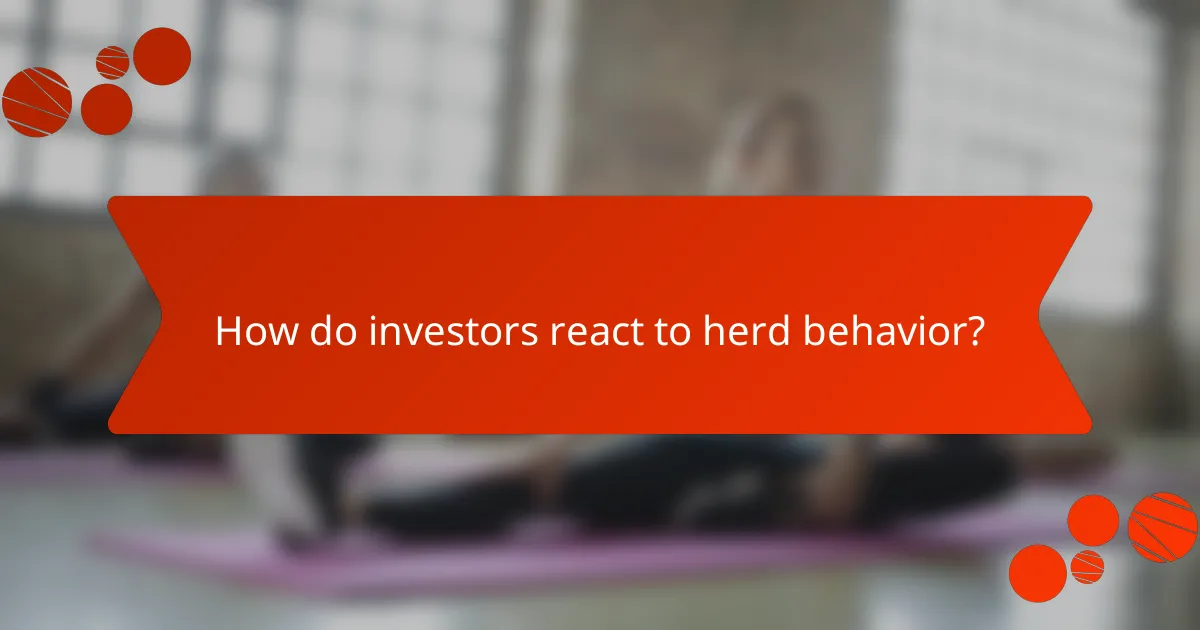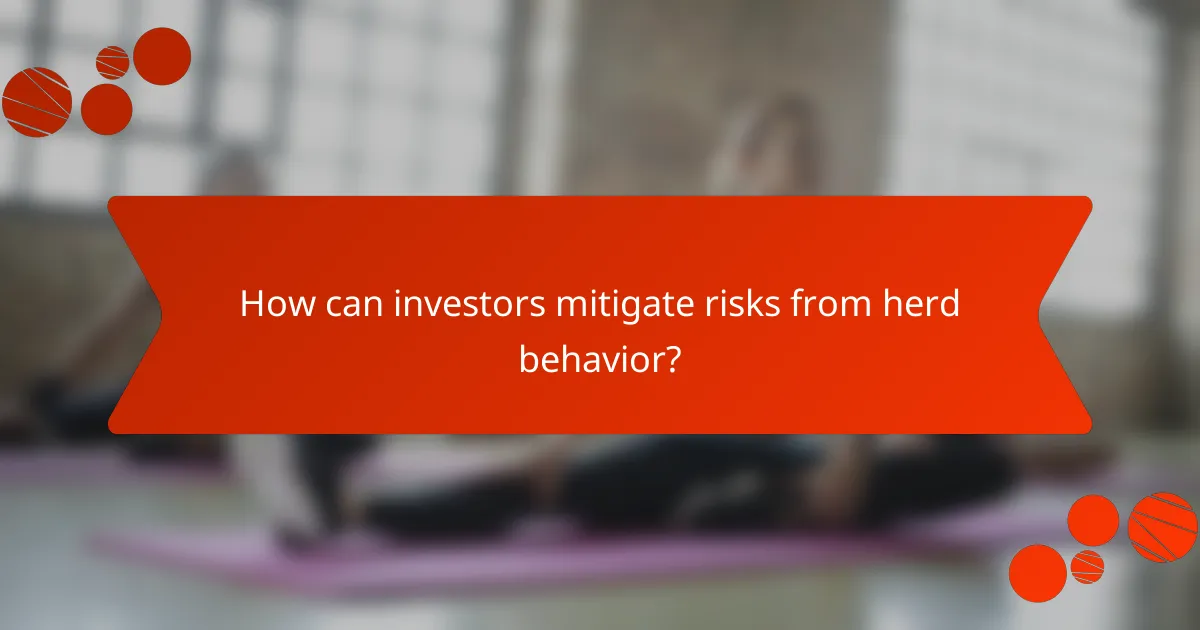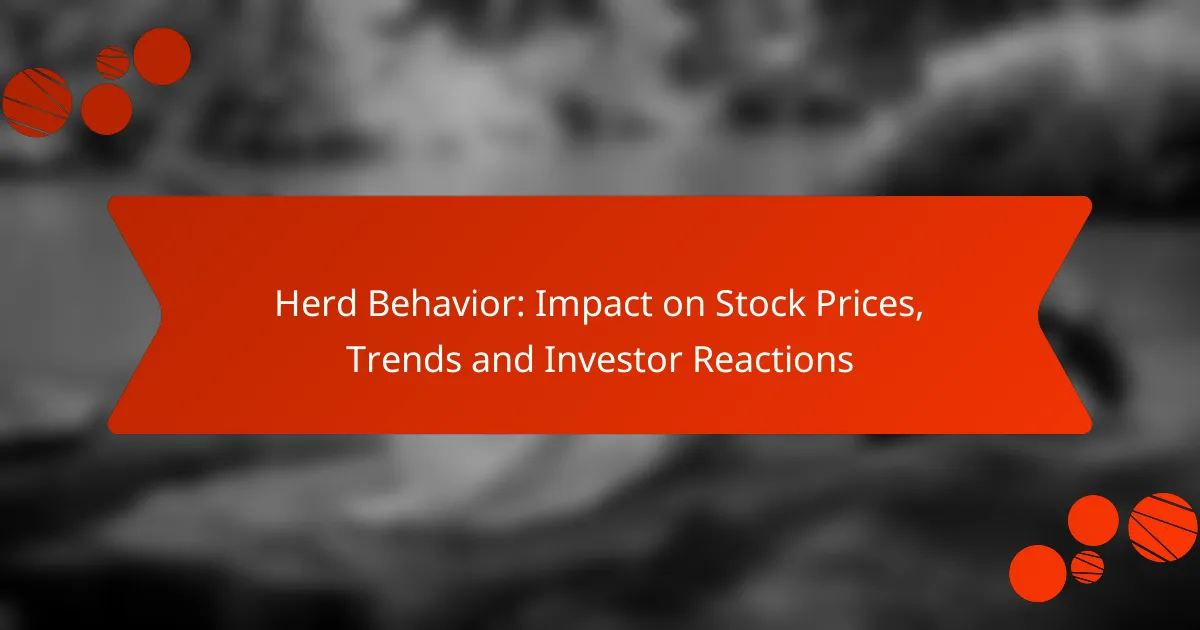Herd behavior plays a crucial role in shaping stock prices in the US market, as investors frequently mimic the actions of others instead of conducting their own analyses. This phenomenon can trigger swift price fluctuations that may not accurately reflect the true value of stocks. Trends such as momentum trading and FOMO (Fear of Missing Out) exemplify how collective decision-making can lead to significant market impacts, often overshadowing fundamental analysis.

How does herd behavior impact stock prices in the US market?
Herd behavior significantly influences stock prices in the US market by causing investors to follow the actions of others rather than relying on their own analysis. This collective behavior can lead to rapid price changes, often disconnected from the underlying value of the stocks.
Increased volatility
Herd behavior can lead to increased volatility in stock prices as large groups of investors react simultaneously to market trends or news. When many investors buy or sell at once, it creates sharp price movements that can be difficult to predict. For example, during earnings announcements or major economic news, stocks can experience swings of several percentage points within a single day.
Investors should be cautious during these volatile periods, as prices may not reflect true value. A common pitfall is to make impulsive decisions based on short-term trends rather than long-term fundamentals.
Price bubbles
Herd behavior can contribute to the formation of price bubbles, where stock prices rise significantly above their intrinsic value due to excessive buying. This often occurs when investors are overly optimistic and ignore warning signs, driven by the fear of missing out (FOMO). For instance, during the dot-com bubble, many investors flocked to tech stocks, driving prices to unsustainable levels.
To avoid getting caught in a bubble, investors should conduct thorough research and remain skeptical of rapid price increases without solid fundamentals. Setting price targets and sticking to them can help mitigate the risks associated with bubbles.
Market crashes
Herd behavior can precipitate market crashes when widespread panic leads to mass selling. When investors see others selling, they often feel compelled to do the same, resulting in a sharp decline in stock prices. Historical events, such as the 2008 financial crisis, illustrate how quickly markets can turn when confidence evaporates.
To protect against potential crashes, investors should diversify their portfolios and maintain a long-term perspective. Having a clear investment strategy and avoiding emotional reactions to market movements can help navigate turbulent times effectively.

What are common trends associated with herd behavior?
Common trends associated with herd behavior include momentum trading and FOMO (Fear of Missing Out). These trends reflect how investors often follow the actions of others, leading to significant impacts on stock prices and market movements.
Momentum trading
Momentum trading occurs when investors buy stocks that are rising in price and sell those that are falling, often influenced by the actions of others. This strategy can lead to rapid price increases as more traders jump on the bandwagon, creating a self-fulfilling prophecy.
Key considerations for momentum trading include timing and market sentiment. Investors should be cautious, as trends can reverse quickly, leading to potential losses. A common heuristic is to look for stocks that have shown consistent upward movement over several weeks or months.
FOMO (Fear of Missing Out)
FOMO drives investors to make impulsive decisions based on the fear of missing profitable opportunities. This emotional response can lead to buying stocks at inflated prices, often after significant price increases have already occurred.
To mitigate FOMO, investors should establish clear investment strategies and stick to them, regardless of market hype. Setting predefined entry and exit points can help manage risks and reduce the likelihood of emotional trading decisions.

How do investors react to herd behavior?
Investors often react to herd behavior by following the majority, which can lead to rapid price movements in stocks. This collective decision-making can result in both positive and negative trends, as individuals may overlook fundamental analysis in favor of popular sentiment.
Follow the crowd
Following the crowd involves investors buying or selling stocks based on the actions of others rather than their own research. This can create a bandwagon effect, where prices soar as more investors jump in, often leading to inflated valuations. For instance, during a market rally, many may invest in trending stocks, driving prices up significantly.
However, this behavior can be risky. If the trend reverses, those who followed the crowd may face substantial losses. It’s essential to recognize when a stock’s price is driven by hype rather than fundamentals.
Contrarian strategies
Contrarian strategies involve going against prevailing market trends, with the belief that the majority can often be wrong. Investors employing this approach may buy undervalued stocks when others are selling or sell overvalued stocks when the market is overly optimistic. For example, during a market downturn, contrarians might see opportunities in fundamentally strong companies that are temporarily undervalued.
This strategy requires careful analysis and a strong conviction in one’s research. While it can yield significant returns when executed correctly, it also carries the risk of holding onto losing positions longer than necessary. Investors should be prepared for volatility and ensure they have a clear exit strategy.

What are the psychological factors behind herd behavior?
The psychological factors behind herd behavior include social proof and groupthink, which significantly influence investor decisions and market dynamics. These factors can lead to irrational decision-making, often resulting in price volatility and trends that may not align with fundamental values.
Social proof
Social proof occurs when individuals look to the actions of others to determine their own behavior, especially in uncertain situations. In the stock market, if many investors are buying a particular stock, others may feel compelled to follow suit, believing that the collective action indicates a sound investment.
This phenomenon can create rapid price increases, as more investors jump on the bandwagon, often disregarding fundamental analysis. However, this can lead to bubbles, where stock prices soar beyond their intrinsic value, making it crucial for investors to remain vigilant and conduct their own research.
Groupthink
Groupthink is a psychological phenomenon where the desire for harmony or conformity within a group leads to irrational decision-making. In investing, this can manifest when a group of investors collectively endorses a particular strategy or stock, suppressing dissenting opinions and critical analysis.
This can result in poor investment choices, as the group may overlook risks or alternative perspectives. Investors should be aware of groupthink and strive to maintain independent thinking, especially during market euphoria or panic, to avoid following the crowd blindly.

How can investors mitigate risks from herd behavior?
Investors can mitigate risks from herd behavior by employing strategies that reduce exposure to market volatility driven by group dynamics. Key approaches include diversification and data-driven decision making, which help maintain a balanced portfolio and informed investment choices.
Diversification strategies
Diversification involves spreading investments across various asset classes, sectors, or geographic regions to minimize risk. By not putting all funds into a single stock or sector, investors can reduce the impact of poor performance in any one area.
A practical approach is to maintain a mix of equities, bonds, and alternative investments. For example, a balanced portfolio might include 60% stocks, 30% bonds, and 10% real estate. This way, if one asset class is affected by herd behavior, others may provide stability.
Data-driven decision making
Data-driven decision making relies on analyzing market trends and financial metrics rather than following the crowd. Investors should focus on fundamental analysis, such as earnings reports and economic indicators, to guide their choices.
Utilizing tools like stock screeners and financial news aggregators can help investors identify undervalued stocks or emerging trends. Setting predefined criteria for buying and selling can also prevent impulsive decisions based on market sentiment.

What role do social media platforms play in herd behavior?
Social media platforms significantly influence herd behavior by amplifying trends and shaping investor sentiment. They facilitate rapid information sharing, allowing investors to react quickly to market movements, often leading to collective decision-making.
Influencer impact
Influencers on social media can sway large audiences, impacting stock prices through their endorsements or criticisms. When a well-known figure promotes a stock, it can lead to a surge in buying activity, regardless of the underlying fundamentals.
For example, a tweet from a prominent investor can cause a stock to rise or fall by double-digit percentages within hours. Investors should be cautious, as following influencers without conducting personal research can lead to poor investment decisions.
Real-time information dissemination
Social media enables real-time sharing of news and market updates, which can trigger immediate reactions from investors. This immediacy can lead to volatile price movements as traders rush to capitalize on perceived opportunities or mitigate losses.
For instance, breaking news about a company’s earnings can spread across platforms in seconds, prompting a rapid shift in stock prices. Investors should monitor social media trends but remain aware of the potential for misinformation and the need for critical analysis before acting on such information.

